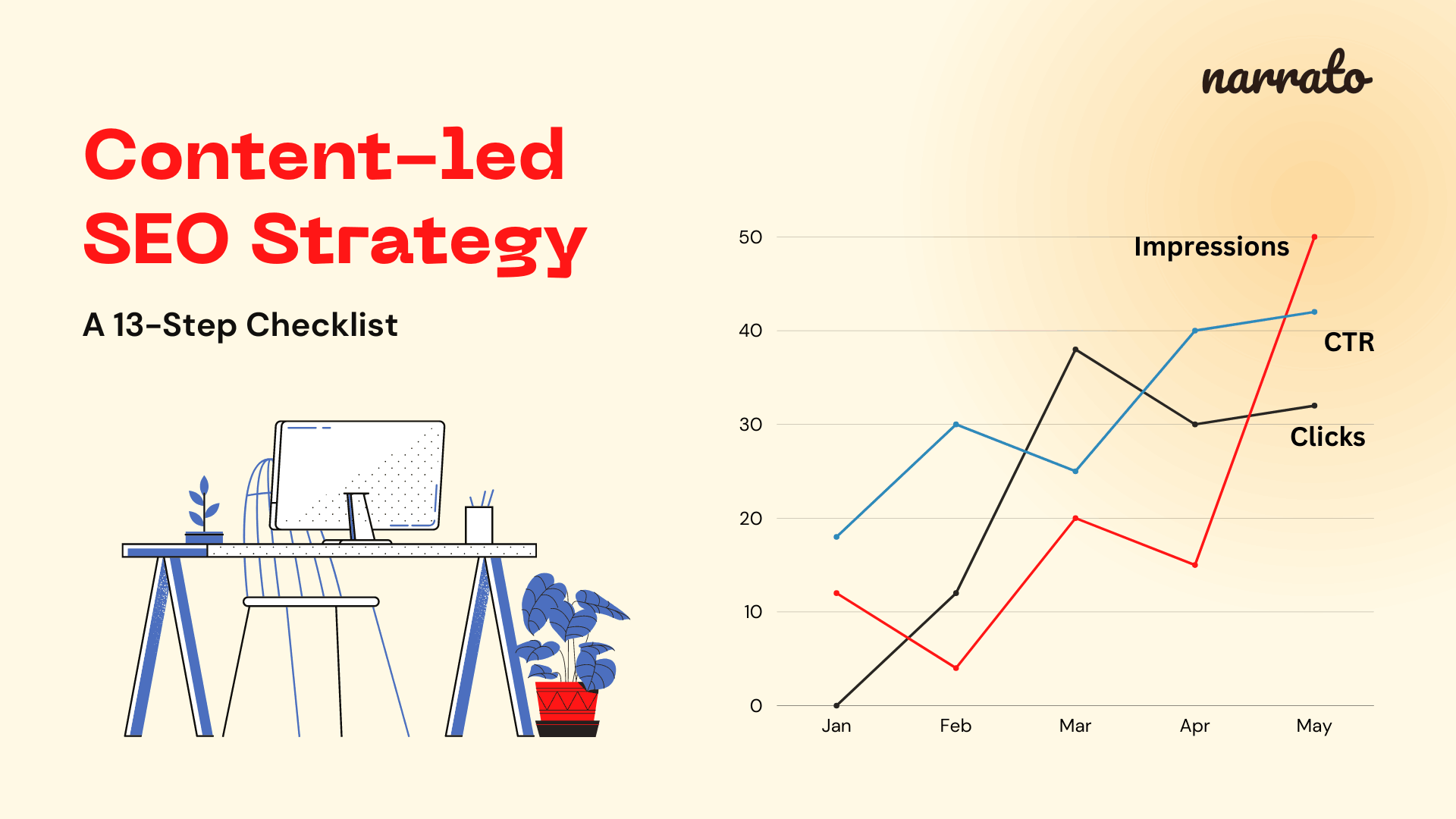When you talk about SEO, what’s the first thing that strikes your mind? If you’re a marketer or a content creator, it has to be content. There are many sides to search engine optimization, including technical SEO, but the role of content is central and crucial in building a well-rounded SEO strategy. So when you are building an SEO strategy, you have to start with content SEO planning first. Be it building a solid keyword strategy or creating content that is link-worthy, a content-led SEO strategy is your ladder to the top of SERPs.
But what exactly is a content-led SEO strategy? And how do you formulate one? This article will share all the tips and hacks you need to successfully implement a content SEO strategy that aids lead generation.
– What is a content-led SEO strategy?
– How to build a content-led SEO strategy with lead generation in mind
- Identify your target audience and create audience personas
- Carry out competitor research
- Brainstorm topic clusters to include in your SEO strategy
- Carry out keyword research
- Determine the best content formats for your SEO strategy
- Create a link building strategy
- Structure your content for better readability
- Pay attention to grammar and avoid content duplication
- Make meta tags an integral part of your content SEO strategy
- Add and optimize images
- Create a content calendar for consistent posting to build site authority
- Update and repurpose old content to boost your SEO strategy
- Analyze your content’s performance

What is a content-led SEO strategy?
A content-led SEO strategy is one where content plays the key role in deciding whether or not you will be able to reach your target audience through organic search. It includes SEO tactics like creating high-quality blog posts, articles, e-books, etc. with strong keyword research, building backlinks to your content, and building authority for your site through content.
Search engines like Google are continuously trying to improve their user experiences, which means they have to serve up content that best meets the user’s needs. This has led to several algorithm changes over the years, one of the latest being the Helpful Content Update. So, content-led SEO also means focusing on your content’s usefulness and delivering value to the audience.
Creating a good amount of search-optimized content and publishing it at a regular frequency can significantly improve your brand’s visibility and bring you out in front of the right prospects. Content-led SEO makes sure that you appear in search for the right queries, satisfy the user’s search intent, answer their most important questions, and build a following for your content.
Content-led SEO also involves some off-page SEO techniques, like building backlinks to your content, guest posting on other blogs, etc. that can drive organic search traffic and build authority for your site as well. We’ll discuss more on this below.
Sounds easy, doesn’t it? If all you have to do is create good content with the right keywords and backlinks, you’ll probably be ranking at the top by next week, right? Well, not really. According to a study by Ahrefs, almost 60% of the pages ranking at no. 1 on Google are at least 3 years old. Even the pages ranking at no. 10 on Google are more than a year old.
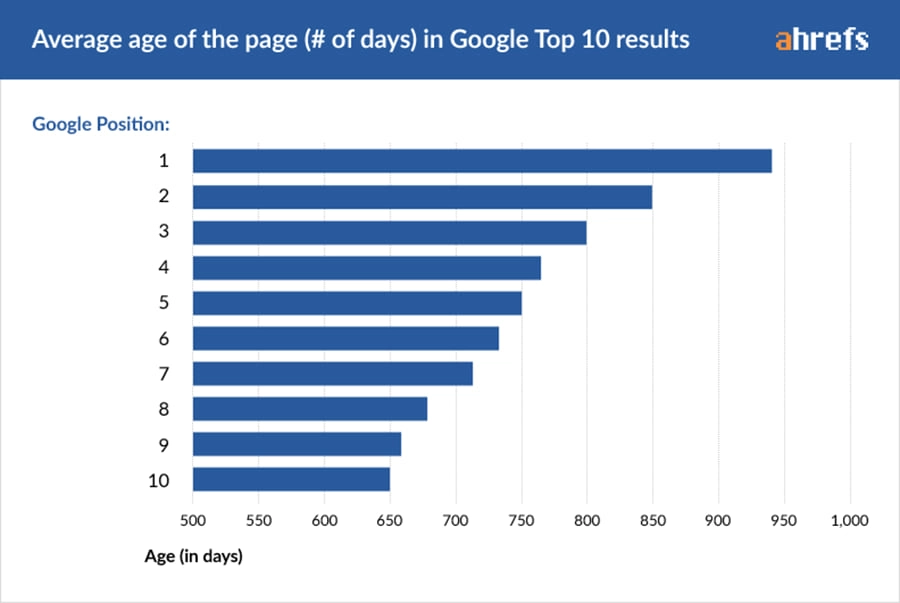
This indicates that content-led SEO takes its time to show results. So if you’re asking – How do I create a proven SEO strategy in 3 months? – you can but the outcomes will be slow, so don’t be disappointed. It requires consistency and patience, sticking to SEO best practices every time you create content.
TL;DR here’s a short video summarizing this article.
How is content-led SEO different from technical SEO?
Technical SEO deals with improving search engine optimization for your website. This includes improving page loading speeds, making web pages responsive to different screen sizes, installing security certificates, etc. These aspects of search engine optimization do not have much to do with the content you are creating.
Content-led SEO, on the other hand, focuses on optimizing the content you create for marketing, and involves both on-page SEO and off-page SEO.
While both technical SEO and content SEO are critical to help your site/blog rank in search, the nuances in content-led SEO are a little more complex, needing very careful research and planning.
So how can you build an effective SEO strategy for lead generation through content? Which are the best SEO strategies? Let’s find out
How to build a content-led SEO strategy with lead generation in mind
When it comes to content marketing, there is one primary goal that no one can overlook – lead generation. Everything that you do in your SEO marketing strategy must help you generate new leads and drive prospects down the sales funnel. The content-led SEO strategy you’re building should also take this into focus.
Here’s how you can master content SEO and lead generation together.
1. Identify your target audience and create audience personas
The purpose of having an SEO strategy is to reach the right audience and drive them closer to an action through content. But how do you do that if you’re not sure who your target audience is? That is why the very first step in content SEO strategy building is identifying your target audience and creating audience personas.
Knowing your target audience allows you to create content that is relevant and useful, and this is extremely crucial for both SEO and lead generation. There are several ways to zero in on your target audience. Here are a few simple questions you could ask yourself –
- Who are your current customers? Gather their demographic data
- Who engages most with your brand on social media?
- Who are your competitors’ target audience/customers?
- Who could benefit from the product/service that you offer?
- What is your brand image and who could it appeal to?
Once you have the answers to these questions, you can further narrow down these prospective users to build your audience personas. Study their online behavior, identify their needs and challenges, look at their past purchases, and more, to know what their preferences are.
This research will help you build a data-driven SEO strategy where picking the right target keywords, page titles, topics, etc. will be a lot easier.
Having well-defined audience personas also makes it easier for the sales and marketing teams to manage customer expectations and provide better experiences.
2. Carry out competitor research
The next step is to know who you’re competing against on your way to the top of SERPs. A strong SEO strategy requires thorough competitor research because if someone is ranking at the top, they’re definitely doing SEO right. And to topple them and take their position on Google search, you’ll have to do better than them.
There are some easy ways to carry out competitor research. One of the first things you could do is type your topic/keyword/search term on Google and see what results pop up. Your biggest competitors are usually the top three organic results on Google search. If you can rank for the keywords they are ranking for and provide a little more value to the audience than what they’re offering, you could probably outrank them. But the catch is, these top-ranking pages are often from very high-authority, established sites. Overtaking them will take years of effort. Competitor analysis will, thus, tell you where to compete and who to compete with.
Another way to find out competitors is using the SEO content brief generator on Narrato. When you generate an SEO content brief for your topic/search term on Narrato, apart from keywords and questions to include, it also offers you a list of competitor links for that topic.
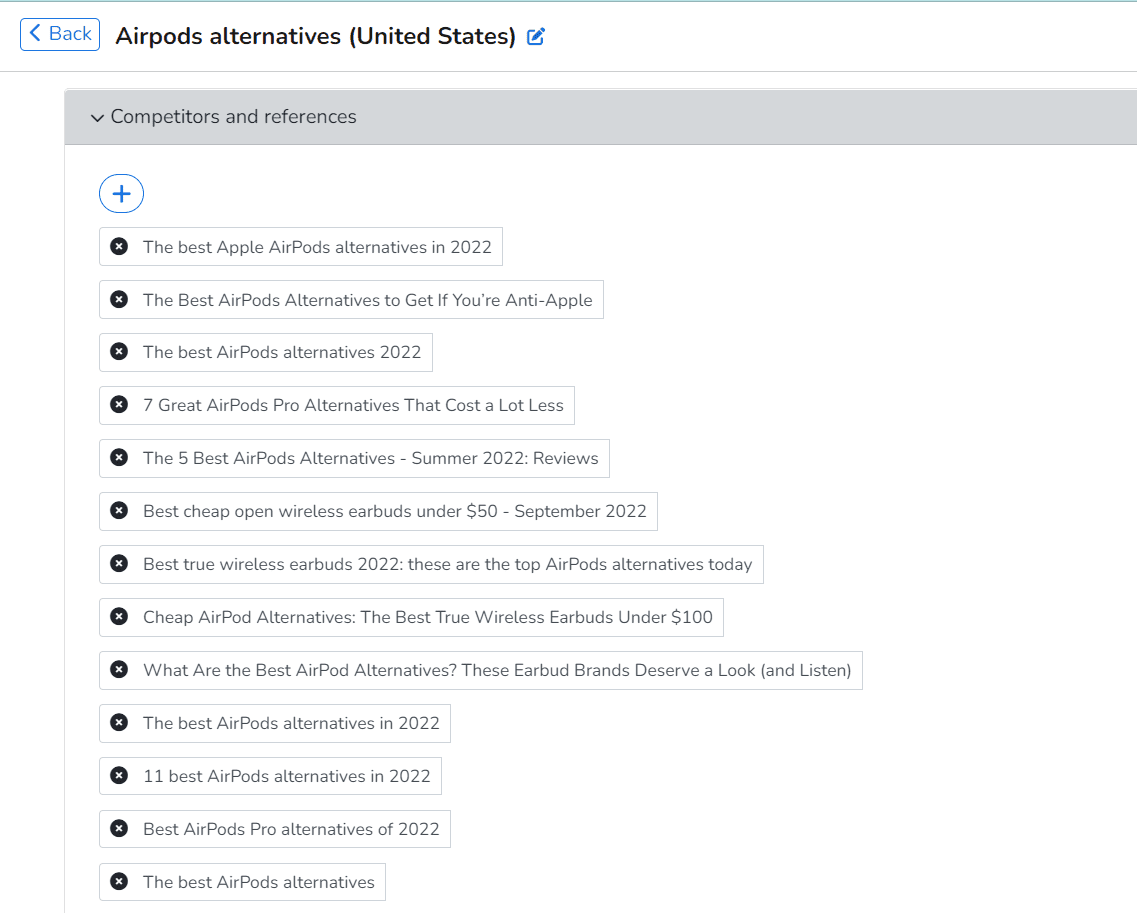
This is great because these are all links obtained from organic search results on SERPs, so you don’t have to sift through sponsored ads, etc. Since you can link the SEO content brief to your content task, the competitor links will be available for ready reference during content creation.
There are several things you can learn from competitive analysis and add to your strategy to improve SEO performance.
Keyword opportunities – Looking at what keywords your competitors are ranking for on a particular topic tell you what keywords you should be aiming for. You will also get ideas for secondary keywords to use, apart from what your SEO content brief gives you.
Content length – Though there’s no official guideline on what content length is ideal to rank in search, it is common knowledge that long-form content is considered more authoritative by search engines. That is because the longer your content, the more likely you are to pack it with value. Competitor research tells you how long the content on the top-ranking pages is. You can then aim for something longer than that to boost your SEO efforts.
Metadata – You will also get an idea of what metadata your competitors are using since this is critical to SEO. What meta title and meta description they use, what is the average length of these sections, etc. can all be important insights.
Content gaps – A huge opportunity that competitive analysis in SEO marketing strategy gives you is identifying gaps in competitor content. Look at what topics they’re creating content on and what questions they’re answering through it. You can also compare it with the ‘Questions to include’ from Narrato’s SEO brief to see what they’ve missed. This gives you an opportunity to fill that knowledge gap for your audience and provide more value. The more valuable your content, the better your chances of outranking others.
Backlink profiles – Your competitor analysis should also help you figure out where they are getting backlinks from. This will uncover new opportunities to build links for your content too. Using backlink checker tools like Moz Link Explorer, Neil Patel’s Backlink Checker, or Ahrefs Backlink Checker can help you analyze your competitors’ backlink profiles. You can then reach out to these sites requesting to replace the competitor link with your links, stating why your content is more in-depth and valuable for their audience.
Competitor research can give you these and a lot of other valuable insights into what works in content-led SEO marketing.
3. Brainstorm topic clusters to include in your SEO strategy
Your content topics are what attract your audience and allow you to leverage your target keywords. Deciding on topic clusters is an important part of creating a successful SEO content strategy.
Topic clusters are an on-site SEO method where you create several content pieces around a single theme. It has a central in-depth post which is called the pillar page and other related posts which are the cluster posts. All cluster posts are interlinked with the pillar page. This gives you the following benefits –
- Interlinking the pillar page and cluster posts indicates to search engines that these are all related posts on a common theme. So search engines consider your site to be an authority on the topic and usually rank you higher for related queries.
- Internal linking also passes on authority from the more authoritative pages to the other pages, helping every blog post scale the ranks.
- Internal links within your topic cluster will help your audience find relevant content, improving the content experience.
A major benefit of creating topic clusters is that you can start ranking with low-competition keywords instead of directly targeting high-competition keywords. Keyword difficulty is one of the main reasons why your content does not rank in search despite being high-quality. The problem is most of the high-volume keywords are already taken up by established sites and competing against them using the same keywords is extremely challenging. With topic clusters, you can gradually build authority for your site using low-competition or low-difficulty keywords. And when your content starts ranking, you can start targeting the tougher keywords with a better chance of ranking.
To decide on topic clusters, you can try the AI topic generator on Narrato. This tool gives you a list of topics around your theme.
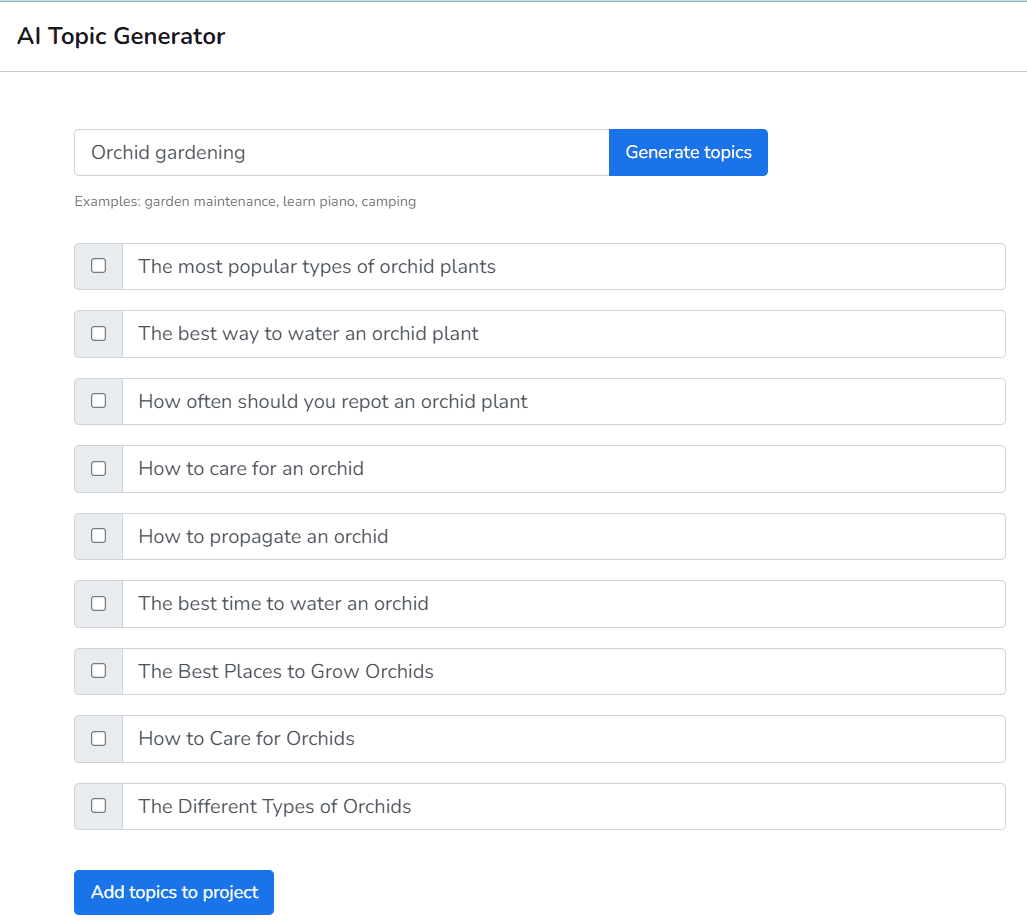
You can pick some of these topics that you find useful and add them to your content cluster. The topics you choose can be directly added to a Project as new tasks on Narrato.
Apart from this, you can also use the autocomplete function on Google search to get topic ideas for your cluster. Not all the suggestions may be relevant or ready to use, but it will surely open up your mind to new ideas.
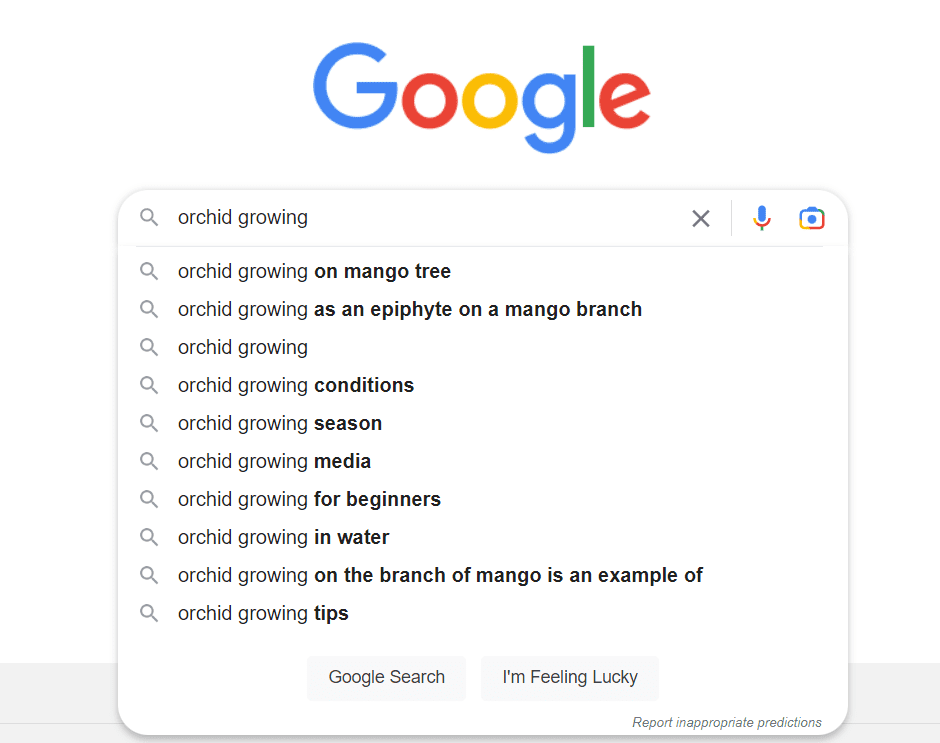
4. Carry out keyword research
Once you have decided on topic clusters, you can now go ahead with your keyword research for each cluster. Having a topic cluster gives you ample opportunity to zero in on the primary keywords you want to target with the different cluster posts you will be creating. Having your keyword plan ready beforehand will also make content planning simpler as it will be easier to decide on titles for your cluster posts.
Here’s how you can go about keyword research keeping in mind your audience’s search intent and your topic clusters.
Choose a primary keyword/search term – To start your keyword planning, you will need a broad search term. This search term must be related to your cluster. Think of what your audience might search for if they were looking for content around your theme. For instance, if your topic cluster is on growing orchids and your target audience is gardening enthusiasts, your broad search term could probably be ‘orchid gardening’ or ‘growing orchids’.
Refer to questions people ask for keyword variations – A single search term may not be enough because people can have different queries related to the same topic. So you have to consider a few variations of your target keyword or search term. A good way to do this is to look at the ‘People also ask’ section in Google search or look at topics your competitors are writing about.
Use a keyword research tool to find related keywords – Finally, create a list of related keywords for these search terms/primary keywords. For this, you can use your favorite keyword research tool. We usually generate an SEO brief on Narrato Workspace that gives us a long list of secondary keywords along with counts for every content piece. So we know how many times to use each keyword within the content without keyword stuffing.
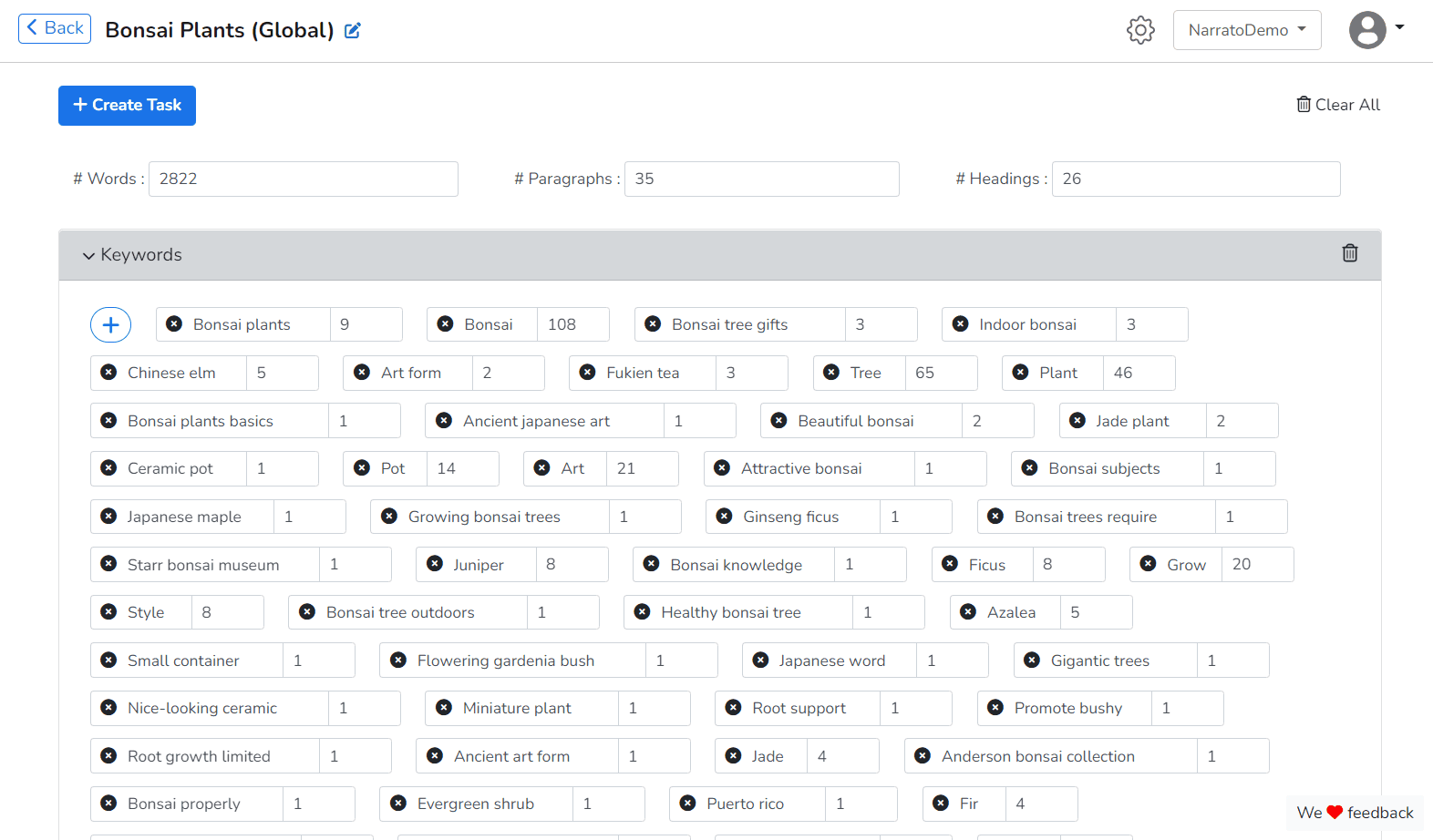
Another highly useful keyword generator tool is the Google Keyword Planner which also shows keyword volume and competition alongside the recommendations.
5. Determine the best content formats for your SEO strategy
The next step in your SEO campaigns is deciding the types of content you want to include in your strategy. There is a wide variety of marketing content types that you can create but not all of them contribute to search traffic equally. For example, it is easier to boost your site’s search engine ranking with written content like blog posts, case studies, etc. but not so much with video or audio content.
But then videos and podcasts are known to drive engagement and improve the audience’s experience. So how do you decide what content to create for successful SEO marketing? Here are a few you can try that will surely help achieve SEO success.
Blog posts – Blog posts are by far one of the best SEO content types that you can easily include in your content strategy. It is also a long-form content type, as most blog posts today are at least longer than 1500-2000 words and that is great for effective SEO. Blog posts can easily accommodate your target keywords, offer tremendous value to your audience, and help you build brand awareness too. Just make sure that you write your blog posts with utmost care and try to answer all your audience’s burning questions.
Other long-form content – Apart from blog posts, some other types of long-form content that can support your SEO strategy are e-books, case studies, research reports, guides, white papers, and the like. These content types allow you to share information in much more depth than a blog post, while also allowing you to include more keywords without affecting the keyword density. Long-form content such as research reports or white papers is also extremely link-worthy. That’s because if you’re sharing original insights, other publishers could willingly link out to your content. This boosts your link-building efforts too, which is great for SEO.
Content with templates – If you’ve followed any of the top SaaS companies today, you must have seen several blog posts that share a free template. Templates are a great way to attract the audience and rank in search as well. Users love templates because it makes the job easier for them as they don’t have to start from scratch. A template gives them a pre-made framework or a base to start from. And that is why most users search for templates online. Creating a separate resource page with free templates helps you target these queries. Many SEO experts at top companies like ClickUp, Qwilr, Airtable, etc. are using this tactic.
Here’s an example of Qwilr’s Templates page that shares hundreds of useful templates for its target users.
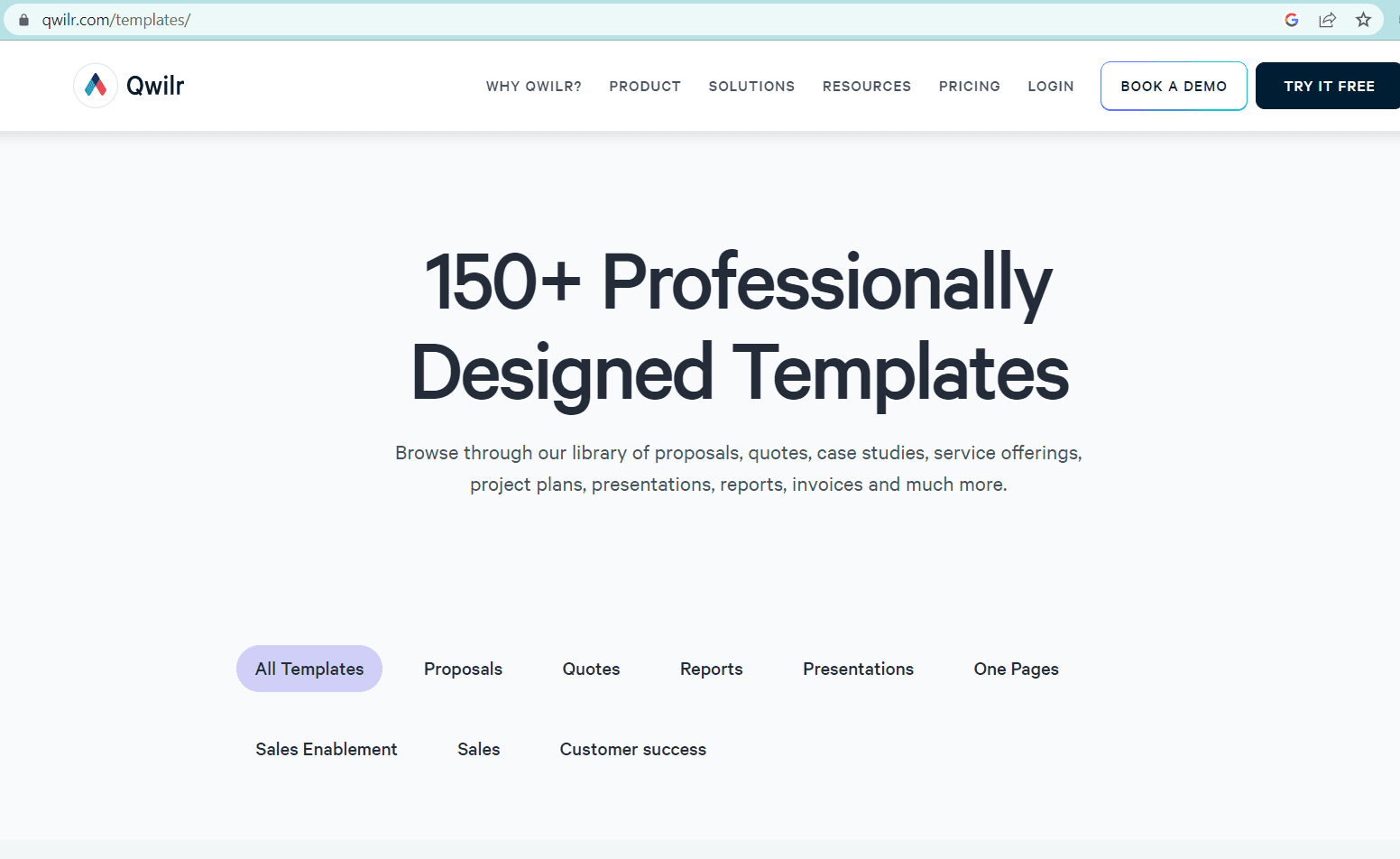
Evergreen content – There are some content types that are time-bound and become irrelevant after a certain point. These may be extremely important right now but in a few months, they will not be driving any search traffic to your blog/website. For example, ‘Top Christmas Deals for 2023’ or ‘What is the best SEO strategy for 2023?’ will no longer get clicks past January 2024. Then there is evergreen content that will remain relevant for years to come. From an SEO perspective, such evergreen content offers better ROI as it will keep driving traffic to your site for longer.
For example, ‘How to Save On Your Christmas Shopping’ is something buyers would probably search for every year. Or ‘How to Stay On Top Of SEO Trends’ is a topic people would still be interested in 2024 and beyond. Moment marketing will bring you instantaneous peaks in clicks and traffic that will quickly die down. Evergreen content will keep the graph steadily climbing.
Thought-leadership content – Another great way to target new keywords and answer audience questions is through thought-leadership content. Thought-leadership content not only offers an original and fresh perspective on a topic, but it is also more click-worthy and share-worthy. This can do wonders for SEO as more people are likely to link out to your content. It will also help build authority for your blog and earn audience trust.
Video content – Though this might seem strange, video content can actually help you rank too. In fact, if you are following the SEO best practices, you have a better chance of ranking through video content than written content. Because there are probably a hundred other articles on the topic but fewer videos. Here’s an example where the first organic search result, apart from the featured snippet, is a video.
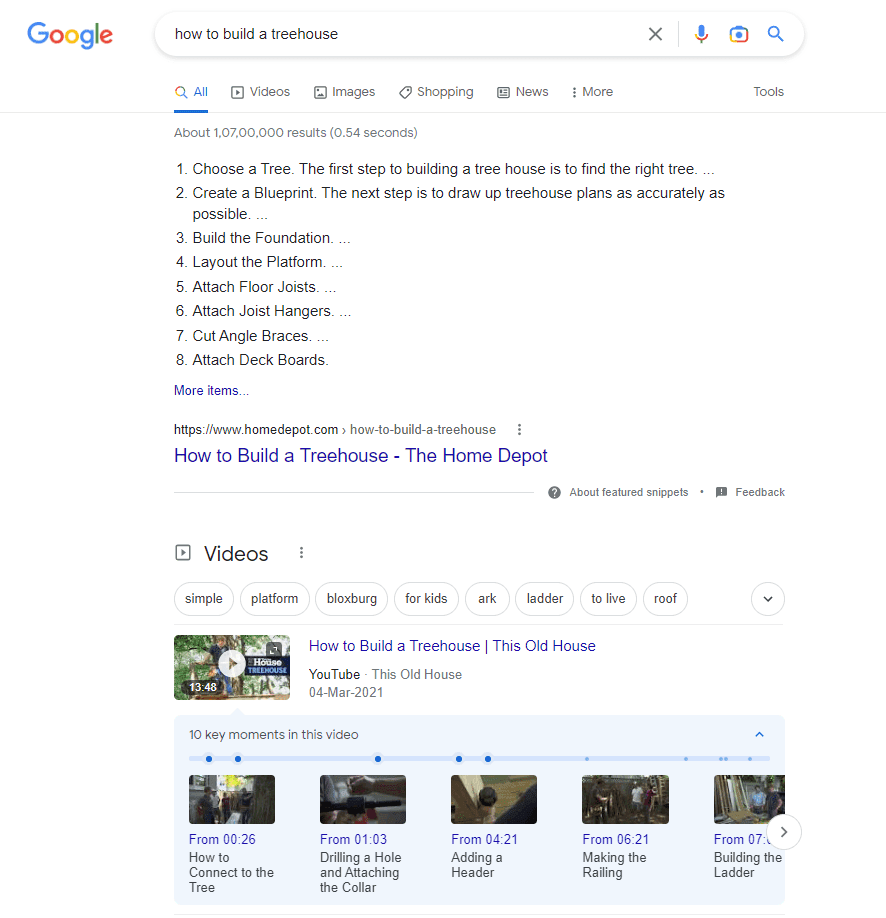
Some good ways to rank in search using video content are –
- Renaming the video file to include the target keyword
- Adding the target keyword to the video title
- Optimizing your video descriptions using relevant keywords
- Adding relevant tags to your videos that will help them appear in the right searches
- Choosing an appropriate thumbnail that urges people to click and aligns with the title
All of these factors can help your video content rank better and get more clicks. If you can perform better than most of the blogs out there, Google might even recommend your video at the top of search results.
6. Create a link building strategy
Building links to your content is crucial for SEO. This includes both internal links and external links from other high-authority websites. For internal linking, we’ve already discussed how important a content/topic cluster is. When you have several posts around a common theme, it becomes a lot easier to link them internally. You can also add internal links on your pages outside the topic cluster, but make sure that the links and the anchor text are relevant.
For external links, however, you will have to put in some extra effort. Off-page SEO strategies like guest posting, adding your links to other blogs, and sharing content with content curation sites can be effective ways to build some valuable backlinks.
Guest posting allows you to create content for a partnering publisher/blog which usually allows you to add one or more links to your own content.
You can also reach out to other blogs with a similar audience and request them to add your link to their content as it could be useful to their readers. We’ve already mentioned how competitive analysis can also help you find link-building opportunities where you can offer to replace an inferior link with a more valuable one from your site. You can even check for broken links on relevant sites and offer to replace them with your links.
Content curation or syndication sites collect valuable resources from their niche/industry to share with their audience. Requesting such sites to include your content can also get you a backlink. There are also other content curation/distribution sites like Medium, Substack, etc. where you can republish your content and link to the original page. Content marketers often ask – what is the best SEO strategy for posting the same article blog to multiple websites? This is the answer to it.
Lastly, make sure that your content is truly valuable. If this criterion is met, it may even attract some organic backlinks as people would voluntarily want to cite it.
7. Structure your content for better readability
This may not be top of your list when thinking of a content SEO strategy, but content structuring does affect search engine optimization too. Content that is clean and easy to skim through is usually ranked better by Google because it offers a better user experience.
There are several on-page SEO tactics that you can employ to improve both readability and search rankings. Here are a few best practices to keep in mind –
- Use the correct hierarchy of Hn tags – H1 for title, H2 for subheadings, H3 for sub-subheadings, and so on
- Keep your paragraphs short. An ideal length is 3-4 sentences per paragraph. Some even recommend paragraphs not longer than 2 sentences
- Keep your sentences short. Ideally, sentences should not be longer than 20 words
- Avoid using passive voice excessively when writing
- Use bulleted and numbered lists wherever possible. They are easier to skim through
Structuring your content better, using shorter paragraphs, or adding numbered/bulleted lists also increases your chances of appearing in the featured snippets on Google.
To ensure better readability in your content, Narrato’s AI content assistant is an appropriate tool for SEO writing with AI. The platform offers readability improvement suggestions such as highlighting excessively long sentences and paragraphs. It also shows a readability score for your content.
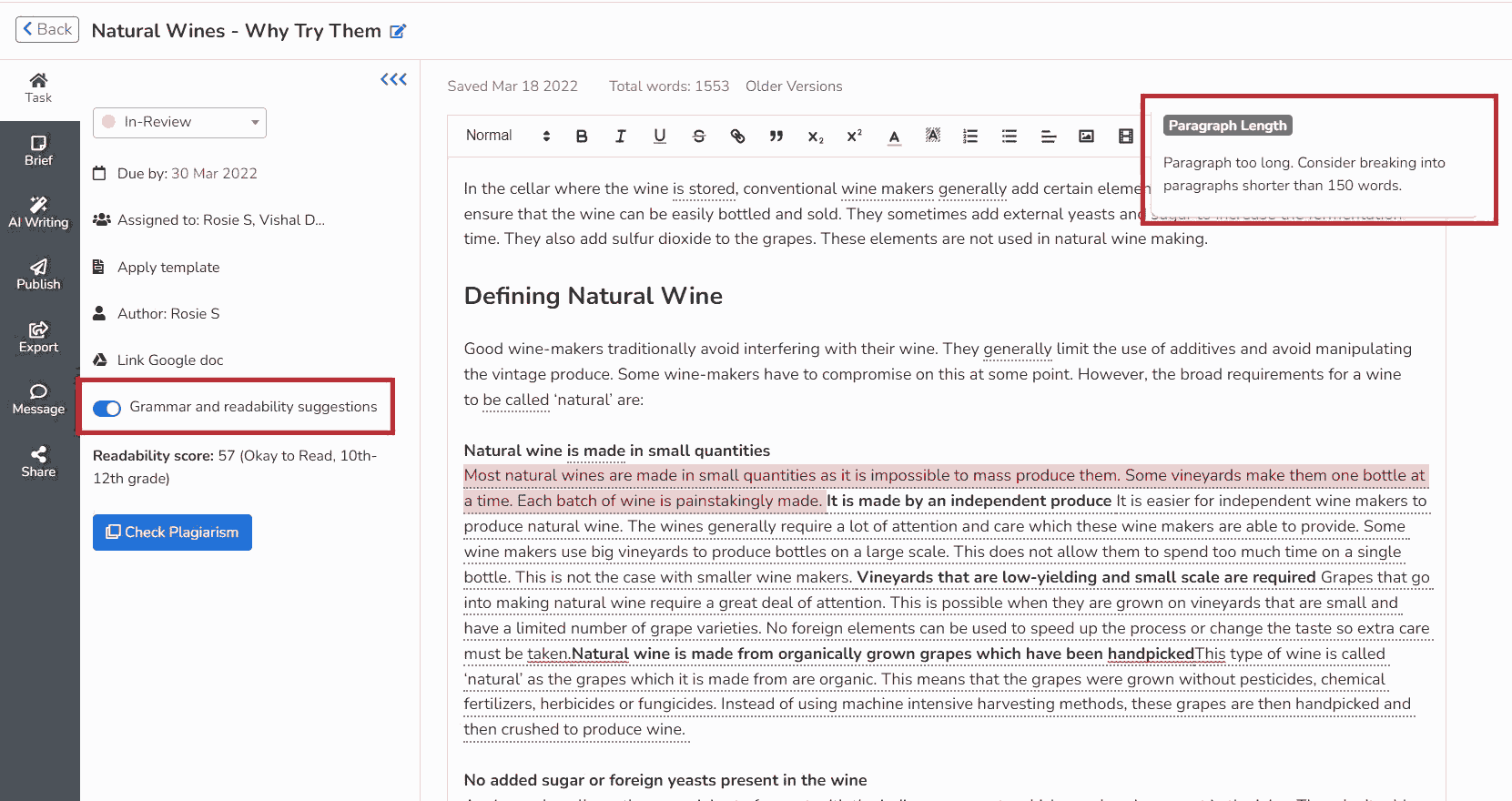
The AI writing assistant on Narrato can also help you improve content readability. It has use cases like Paragraphs-to-bullets, Content Improver, etc. that can help you structure your content better. To give your writers a better understanding of the content structure you want, you can even create custom content templates on Narrato with detailed instructions added to each field. Applying content templates ensures that there’s consistency in your content no matter who is creating it.
Adding a platform like Narrato to your SEO tool stack can be a good investment, given that it offers so many unique benefits.
8. Pay attention to grammar and avoid content duplication
Though there is no solid evidence that grammar affects content rankings on Google, it is important to remember that bad grammar is a quality issue. And Google does not take content quality issues lightly. If your content has too many grammar mistakes, it is likely that people will start abandoning your page sooner and Google will notice it. Eventually, your page ranking is bound to dip.
So ensuring that your content is free of any such quality issues is vital. A grammar checker tool can help here. If you’re creating content on Narrato, it would be the least of your worries as the content optimization tool highlights any grammatical errors and even suggests improvements. It will highlight redundant words, spelling errors, or excessive use of passive voice, helping you improve content quality.
Another major issue that can bring your rankings down instantly is duplicate content. If Google detects any kind of plagiarism in your content, it penalizes the page and brings its search rankings drastically down. Usually, a plagiarism score of less than 10% is considered safe, but we would recommend keeping it as low as possible and preferably nil. Narrato’s plagiarism checker can help you with this. It lets you run plagiarism checks on your content and highlights duplication issues that need fixing.

9. Make meta tags an integral part of your content SEO strategy
A very critical but easily overlooked factor in content SEO is meta tags. Many times content marketers either forget to add a meta tag to their content. Or they simply use their post title and a random excerpt from their post as meta title and meta description respectively.
It is important to remember that when search engines crawl and index your page, it is these meta tags that they crawl. So if your meta title does not meet the ideal length or the meta description does not have the primary keyword, your content will probably never get to the first page.
Here are a few meta tag best practices that you must implement for successful on-page SEO.
- Keep your meta titles unique and descriptive of what the page contains, without making it excessively long
- Limit your meta titles to just 50 to 60 characters
- Include your primary keyword closer to the beginning of the title tag and make sure it fits naturally
- Create a unique meta description summarizing the page instead of simply copy-pasting the first few lines of your post
- Add the primary keyword closer to the beginning of the meta description
- Always use sentence case, make it conversational, and add a CTA at the end of the meta description if possible
- Keep your meta descriptions close to 150 to 160 characters
- Make sure your meta description aligns with a user’s search intent
These are a few preliminary things that you need to take care of and over time, you will learn how to improve your meta tags. If you find it hard to come up with unique meta tags every time, Narrato’s AI writer has an SEO meta description use case to assist you. Here’s an example.
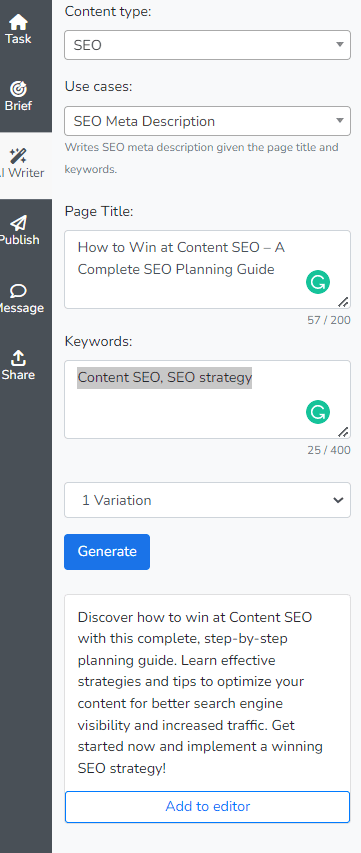
10. Add and optimize images
Images are an integral part of any marketing content, be it in the form of an infographic, a screenshot, or even a stock image relevant to your post. Images can even improve the content experience by breaking the monotony of text. But if you are not careful, images can even hamper search engine optimization. Using images that are too large can increase your page loading time. Also, images without any alt tags will add no SEO value to the content.
Always optimize the images that you add to your content. Here are some image optimization best practices to follow for content SEO –
- Compress and resize your images to give you the best loading speeds without compromising too much on quality
- Choose the right image file format. JPEG images are smaller in size, PNG images offer better quality, and so on
- Optimize the image file names by adding relevant keywords
- Use alt tags in every image and make sure it includes the primary keyword. Alt tags should describe the image as concisely as possible
- Don’t embed any important text within the image as it will not be accessible to search engines for ranking purposes
- Place images appropriately near the most relevant text in your posts
- Use a good URL structure for images that helps search engines understand what the image is about
11. Create a content calendar for consistent posting to build site authority
To get visible results with content-led SEO, consistency in posting content is critical. If you’re publishing one blog post today and the next one 4 months down the line, it would be near impossible to build authority for your site. Posting content at regular and frequent intervals is imperative in SEO marketing.
To help with this, you must have a content calendar where you can plan all your content for at least a month ahead. Narrato’s content calendars for example allow you to add content tasks, assign tasks, and move deadlines very easily. It also lets you track your content tasks’ progress through color-coded workflow statuses. For instance, Red indicates Drafting, Green indicates Published, etc. depending on how you customize your content workflow.
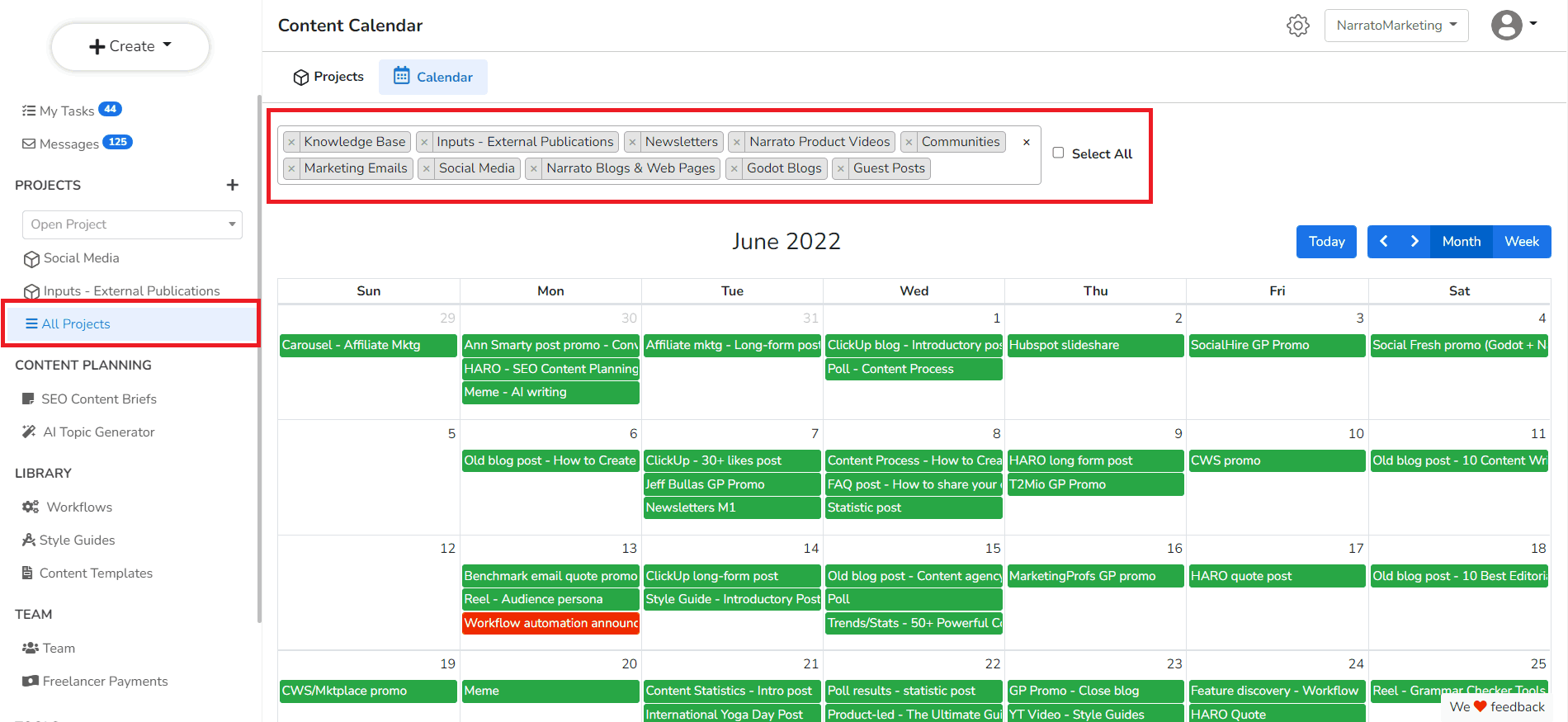
Efficient content planning is crucial for successful SEO campaigns and in this, a content calendar is your best friend.
12. Update and repurpose old content to boost your SEO strategy
Your content-led SEO strategy does not just apply to new content but also to your existing content. There is always scope to update and optimize your old blog posts to help them rank better in search. A content SEO audit from time to time will give you the necessary insights to help you identify such opportunities.
Using tools like Google Analytics and Google Search Console, you can run SEO audits on your site to see which of your existing pages are performing well and which are not. You can gather data such as impressions, click-through rates, and average page rankings for all the pages on your site. With this data, you can identify which blog posts have the potential to perform better with a little optimization. You can start building links for those posts and even revisit the keyword strategy, incorporating newer and stronger keywords in your existing content.
Some of the evergreen content on your blog may even be suitable for repurposing to increase its reach. For instance, an in-depth blog post can probably be turned into an e-book with a little effort. You can also repurpose your blog content into short videos or video tutorials to reach an even wider audience and increase the scope of your SEO campaign.
Updating and repurposing your old content makes sure that your best content does not lose its relevance over the years.
13. Analyze your content’s performance
Running an SEO audit serves more than one purpose. Apart from helping you optimize older content, it also gives you information on your content’s SEO performance. When you are putting so much effort into building your SEO strategy and executing it, making sure that it is driving the desired results is essential. You need to set certain key performance indicators (KPIs). These could be your average search rankings, organic traffic, CTR, conversions, or other metrics depending on what your goals are.
If you see these metrics growing slowly but steadily, your content SEO strategy is probably working. If not, you will have to revisit it and figure out what’s lacking. It is also important to note that search engine algorithms keep changing and a tactic that worked for you a few months ago may become obsolete the moment a major update is released. So continuously monitoring your SEO performance and reconsidering your SEO strategy is indispensable.
We’ve created a comprehensive content SEO checklist, so you don’t miss any of these steps when building your content-led SEO strategy.
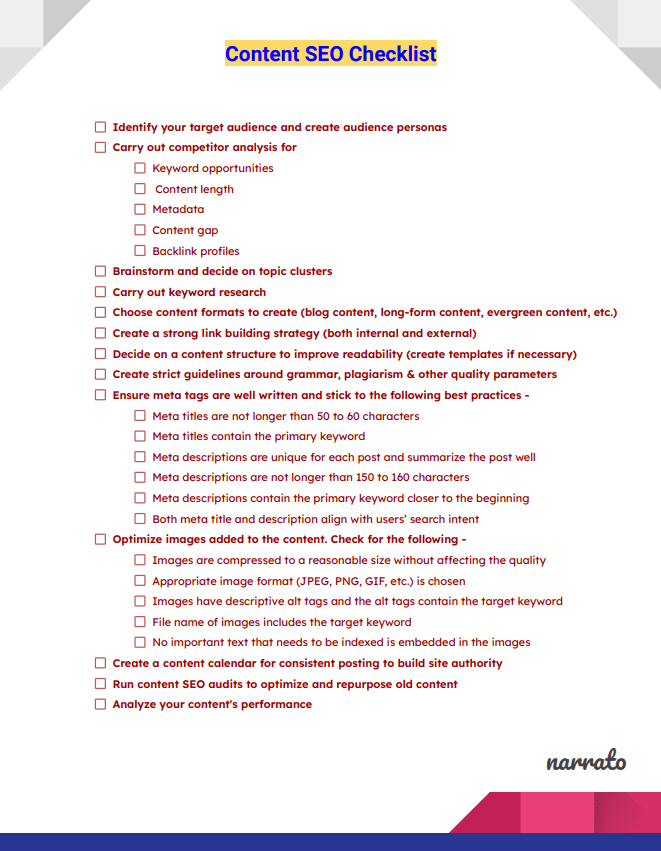
You can download this checklist as a Word document here or as a PDF file here.
Wrapping up
A content-led SEO strategy if built and implemented well can drive phenomenal results for your brand and business. People who find you through organic search are more likely to trust your brand and will be easier to retain in the long run. So whatever effort it takes to reach them is worth it. Content-led SEO involves extensive research, a good understanding of your target market, and continuous improvement in small iterations. The results may not be visible instantly, but they are sure to come. Being patient and consistent is the key to SEO success. Hope these few tips we’ve shared will help you create amazing search-optimized content that drives leads and conversions.


